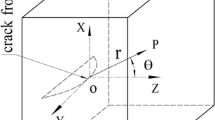Abstract
A new experimental approach for evaluating stress intensity factor was recently suggested by the authors (He et al. in Int J Solid Struct 78–79:131-137, 2015b). It is based on a linear relationship between the remote stress intensity factor and the out-of-plane surface displacements in the close vicinity of the vertex point. Dimensionless considerations, 3D FEM and DIC technique were attracted to establish and validate this relationship. However, these new developments were limited to through-the-thickness cracks subjected to mode I loading only. This brief note extends the above-mentioned approach to mode II and, eventually, to mixed mode loading.






Similar content being viewed by others
References
Anderson TL (1995) Fracture mechanics: fundamentals and applications. CRC Press, Boca Raton
Ayatollahi MR, Aliha MRM, Saghafi H (2011) An improved semi-circular bend specimen for investigating mixed mode brittle fracture. Eng Fract Mech 78:110–123
Ayatollahi MR, Nejati M (2011) Experimental evaluation of stress field around the sharp notches using photoelasticity. Mater Des 32:561–569
Bazant ZP, Estenssoro LF (1979) Surface singularity and crack propagation. Int J Solid Struct 15:405–426
Berto F, Lazzarin P, Kotousov A (2011a) On higher order terms and out of plane singular mode. Mech Mater 43:332–341
Berto F, Lazzarin P, Kotousov A (2011b) On presence of the out-of-plane singular mode induced by plane loading with KII = KI = 0. Int J Fract 167:119–126
Courtin S, Gardin C, Bezine G, Hamouda HBH (2005) Advantages of the J-integral approach for calculating stress intensity factors when using the commercial finite element software ABAQUS. Eng Fract Mech 72:2174–2185
Dally JW, Sanford RJ (1987) Strain-gage methods for measuring the opening-mode stress-intensity factor \(\text{ K }_{{\rm I}}\). Exp Mech 27:381–388
Dehnavi MRY, Eshraghi I, Soltani N (2013) Investigation of fracture parameters of edge V-notches in a polymer material using digital image correlation. Polym Test 32:778–784
Desai CK, Basu S, Parameswaran V (2012) Determination of complex stress intensity factor for a crack in a bimaterial interface using digital image correlation. Opt Lasers Eng 50:1423–1430
Ewalds HL, Wanhill RJH (1984) Fracture mechanics. Edward Arnold Ltd, London
He Z, Kotousov A, Berto F (2015a) Effect of vertex singularities on stress intensities near plate free surfaces. Fatigue Fract Eng Mater Struct 38:860–869
He Z, Kotousov A, Fanciulli A, Berto F, Nguyen G (2015b) On the evaluation of stress intensity factor from displacement field affected by 3D corner singularity. Int J Solid Struct 78–79:131–137
Kotousov A (2010) Effect of plate thickness on stress state at sharp notches and the strength paradox of thick plates. Int J Solid Struct 47:1916–1923
Kotousov A, Lazzarin P, Berto F, Harding S (2010) Effect of the thickness on elastic deformation and quasi-brittle fracture of plate components. Eng Fract Mech 77:1665–1681
Kotousov A, Lazzarin P, Berto F, Pook LP (2013) Three-dimensional stress states at crack tip induced by shear and anti-plane loading. Eng Fract Mech 108:65–74
Kotousov A, Tan PJ (2004) Effect of the plate thickness on the out-of-plane displacement field of a cracked elastic plate loaded in mode I. Int J Fract 127:L97–L103
Kwon SW, Sun CT (2000) Characteristics of three-dimensional stress field in plates with a through-the thickness crack. Int J Fract 104:291–315
Lim I, Johnston IW, Choi SK (1992) On stress intensity factor computation from the quarter-point element displacements. Commun Appl Numer Methods 8:291–300
McCormick N, Lord J (2010) Digital image correlation. Mater Today 13:52–54
McNeill SR, Peters WH, Sutton MA (1987) Estimation of stress intensity factor by digital image correlation. Eng Fract Mech 28:101–112
Nakamura T, Parks DM (1988) Three-dimensional stress field near the crack front of a thin elastic plate. J Appl Mech 55:805–813
Pfaff RD, Washabaugh PD, Knauss WG (1995) An interpretation of Twyman-Green interferograms from static and dynamic fracture experiments. Int J Solid Struct 32:939–955
Pook LP (1994) Some implications of corner point singularities. Eng Fract Mech 48:367–378
Pook LP (2000) Crack profiles and corner point singularities. Fatigue Fract Eng Mater Struct 23:141–150
Pook LP (2013) A 50 year retrospective review of three dimensional effects at cracks and sharp notches. Fatigue Fract Eng Mater Struct 36:699–723
Ravi-Chandar K (2004) Dynamic fracture, 1st edn. Elsevier, Amsterdam
Ravi-Chandar K (2008) Fracture mechanics. In: Sharpe WN (ed) Springer handbook of experimental solid mechanics. Springer, New York, pp 125–158
Rosakis AJ, Ravi-Chandar K (1986) On crack-tip stress state: an experimental evaluation of three-dimensional effects. Int J Solids Struct 22:121–134
Sutton A, Orteu JJ, Schreier HW (2009) Image correlation for shape motion and deformation measurements. Springer, New York
Theocaris PS, Gdoutos E (1972) An optical method for determining opening-mode and edge sliding-mode stress-intensity factors. J Appl Mech 39:91–97
Williams ML (1957) On the stress distribution at the base of a stationary crack. J Appl Mech 24:109–114
Yang W, Freund LB (1985) Transverse shear effects for through-cracks in an elastic plate. Int J Solids Struct 21:977–994
Yoneyama S, Morimoto Y, Takashi M (2006) Automatic evaluation of mixed-mode stress intensity factors utilizing digital image correlation. Strain 42:21–29
Zhang R, He L (2012) Measurement of mixed-mode stress intensity factors using digital image correlation method. Opt Lasers Eng 50:1001–1007
Zhu WX, Smith DJ (1995) On the use of displacement extrapolation to obtain crack tip singular stresses and stress intensity factors. Eng Fract Mech 51:391–400
Author information
Authors and Affiliations
Corresponding author
Rights and permissions
About this article
Cite this article
He, Z., Kotousov, A., Fanciulli, A. et al. An experimental method for evaluating mode II stress intensity factor from near crack tip field. Int J Fract 197, 119–126 (2016). https://doi.org/10.1007/s10704-015-0062-x
Received:
Accepted:
Published:
Issue Date:
DOI: https://doi.org/10.1007/s10704-015-0062-x




